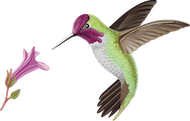As the Gottlieb Native Garden’s naturalist, Scott Logan documents the ever-changing array of wildlife species as they vary with the garden’s blooms, seasons and migratory patterns. While bringing these observations to life for all to experience, he also coordinates scientific research projects, and monitors the overall health and biodiversity of the garden. The Naturalist’s Journal also highlights the work the Gottliebs and Scott are doing to educate and inspire people to start gardening for wildlife with native plants.
Un-Invited snail guests
I had never noticed aquatic snails in any of the Garden’s water features until one day in the upper pond I saw what seemed to be 1000s of them! Apparently when conditions are favorable, the Acute Bladder Snail – Physella acuta can reproduce very quickly. […]
Happy valentines day ♡
Two Band-tailed Pigeons share an intimate moment…
Feralia februalis – Master of camouflage
The majority of North American moths are seasonal, flying only during particular months of the year. Here in the GNG, one of my favorite winter flying moths is the Feralia februalis. This species of owlet moth can be found only in the dry woodlands of […]
Arizona Mantis
The Arizona Mantis – Stagmomantis limbate is one of two native mantises found in the GNG. Emerging from their egg cases earlier this year, these mantises would have gone through several molts until developing into adults during the past summer. They began breeding this fall […]
Native Pollinators come with delicious benefits!
Here is a perfect example of how we, and wildlife, benefit from native pollinators. In early summer our prickly pear cactus plants flower and insects are immediately attracted to them. Among those insects will be bees in the tribe known as Eucerini , or Longhorn […]
Orbweavers cat and mouse mating game
The arrival of fall means orb weaver spiders, and their webs fill the Garden. This is also the breeding season for many spiders, including the Spotted Orbweaver – Neoscona crucifera. In the video below, a male Spotted Orbweaver is determining if it’s the right time to […]
Summer night skies are alive with Bats
Bat activity in the Garden is always at its height during the Summer months. This year during July, August and September our ultrasonic recorder picked up 4900 individual calls from possibly 10 species of bats. Eight of them are currently on our vetted bat species […]
Cuckoo bees
I just found another species of Cuckoo bee in the Garden – Genus Coelioxys ! Cuckoo bees are kleptoparasites, meaning they employ a feeding strategy where they steal food from another. In their case, it’s their young that rob other bee larvae of their food […]
native bee identification
For the most part, I do not collect specimens for identification. I carry out most of my documentation with photographs. Unfortunately, most insects are very difficult to ID beyond family, sub-family or Genus with images alone. For this reason, at times I will choose to […]
carrion plant
The transformation of the GNG began in 1990, not as a California native garden, but as a drought-tolerant Mediterranean garden. But it wasn’t long before the connection between native plants and the survival of native wildlife was made. During the proceeding years, the majority of […]

